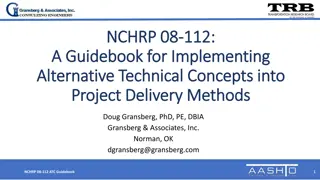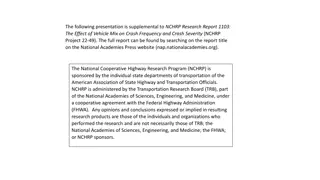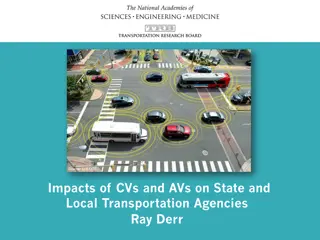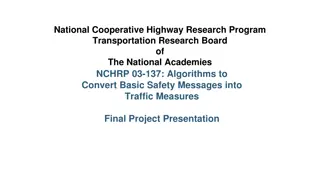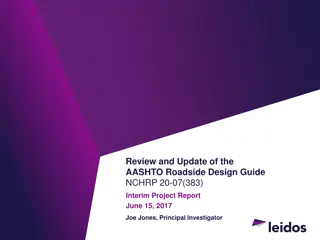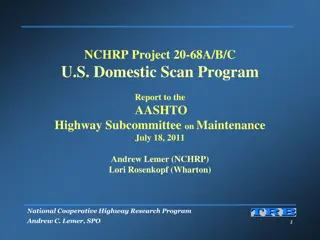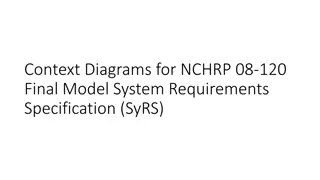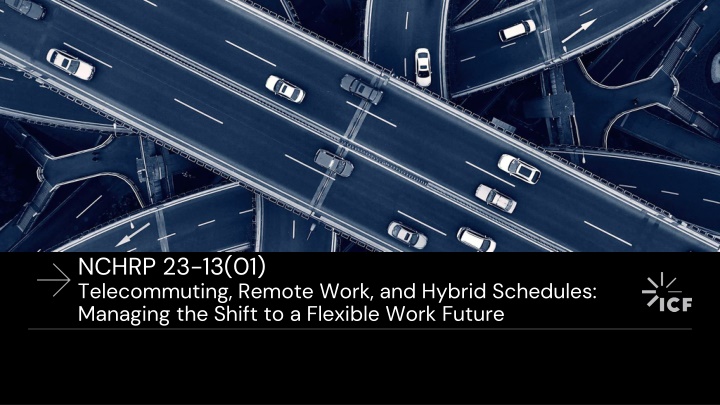
Managing a Shift to Flexible Work Environments in State DOTs
Explore the NCHRP project focusing on telecommuting, remote work, and hybrid schedules in state DOTs. Develop user-friendly resources to assess employee suitability for flexible work environments, including tools, guides, and best practices. Dive into telework options, benefits, challenges, and performance measurement strategies.
Download Presentation

Please find below an Image/Link to download the presentation.
The content on the website is provided AS IS for your information and personal use only. It may not be sold, licensed, or shared on other websites without obtaining consent from the author. If you encounter any issues during the download, it is possible that the publisher has removed the file from their server.
You are allowed to download the files provided on this website for personal or commercial use, subject to the condition that they are used lawfully. All files are the property of their respective owners.
The content on the website is provided AS IS for your information and personal use only. It may not be sold, licensed, or shared on other websites without obtaining consent from the author.
E N D
Presentation Transcript
NCHRP 23-13(01) Telecommuting, Remote Work, and Hybrid Schedules: Managing the Shift to a Flexible Work Future
Project Goal To help state DOT leadership, management, and employees consider long-term and wide adoption of flexible working environments by developing user-friendly resources to help assess the suitability of employees and positions for a flexible work environment. The deliverables also support the aggregation of assessments for reporting to agency leadership.
Work Performed Developed Final Deliverables Developed Telework Suitability Tool for assessing employee suitability for telework, Tracking Tool, and Guide with associated guidance and tools for managers related to telework and other FWAs, including implementation best practices, measuring employee performance and productivity, and determining program success. Facilitated Interviews Identified state DOT contacts with telework experience or expertise; conducted interviews to understand the benefits, challenges, and risks associated with telework within state DOTs; and identified best practices for evaluating success and potential criteria to determine suitability. Conducted Literature Review Reviewed literature to sharpen our existing knowledge of flexible work arrangements (FWAs), understand recent state DOT experience with FWAs, and identify successful practices and key considerations. 3
Guide Overview Designed to provide state DOTs with a resource to: Understand different telework and FWA options Understand benefits and challenges of telework Determine if the agency is ready to implement a telework program Measure performance and productivity of an employee who is teleworking Measure telework program effectiveness Use tools to determine employee suitability for telework and tracking established arrangements 4
Guide Overview The Guide is made up of three sections: Chapter I. Introduction Telework Options Benefits and Challenges of Telework Organizational Readiness Alternatives to Telework Best Practices Chapter II. Telework Tools Telework Suitability Tool Tracking Tool Instructions Chapter III. Measuring Performance and Productivity Best Practices for Monitoring and Measuring Productivity and Performance Metrics for Measuring Telework Program Effectiveness 5
Chapter I. Introduction - Telework Options and Alternatives to Telework Telework Options Alternatives to Telework The employee has the flexibility to decide when they start and end their workdays, typically around a set of core hours. This allows them to work during their preferred working hours (e.g., early in the morning), and avoid long commutes. Flexible Time Ad Hoc Hybrid Telework Ad hoc hybrid telework is when an employee works primarily in the office/on site but can potentially telework with approval on an as-needed basis. Full-Time Telework Often called remote work, telework includes employees working exclusively away from the office/site every day. Part-time work involves the employee working less than 40 hours per work week. This allows them to maintain employment while balancing personal time or demands (e.g., school, family, non-paid work). The organizations can use this option to hire or retain valued staff as well as provide support to other employees with high or fluctuating demands. Part Time Hybrid Telework Hybrid telework involves an established schedule where an employee works some days in the office/on site and works remotely on other days. More than one employee shares or divides the duties of one full-time position. This can allow the organization to meet the demands of a full-time position while hiring employees who might not otherwise be able to commit to a full-time job. Job Sharing Often referred to as 4-10s or 9-9s, this practice allows the employee to work more hours in a workday in order to work a lower number of workdays (e.g., four 10-hour workdays with one day off every week, nine 9-hour workdays with one day off every other week). This allows the employee to have more consecutive days off, which can be valuable to the employee, but this does not offer as much flexibility for unexpected events/emergencies. Compressed Work Week 6
Chapter I. Introduction One-pagers for each telework option and alternatives to telework that provide a high-level overview, potential benefits, challenges, and implementation best practices for each. Benefits of telework including in-depth information and research related to the recruitment and retention benefits for state DOTs. Challenges and mitigation strategies including working with a union, gaining buy-in, measuring performance and productivity, and addressing the lack of social interaction. Determining organizational readiness for telework, implementation actions, and an organizational readiness checklist. Common practices of telework implementation and best practices to strive for.
Chapter II. Telework Tools Telework Suitability Tool To be used by managers to determine if their employee is suitable for a telework arrangement Manager responds to a series of questions with yes (most of the time) or no, and in some cases, at times Once all questions are answered, the tool will populate one or more potential telework options, including: Not Suitable for Full-Time Telework May be Suitable for Ad Hoc Hybrid Telework May be Suitable for Hybrid Telework May be Suitable for Telework Instructions provided include: Completing the Telework Suitability Tool Telework Suitability Tool Criteria Editing a question in the Telework Suitability Tool Adding a new question to the Telework Suitability Tool Conversation guidance for manager and employee 8
Chapter II. Telework Tools Tracking Tool To track approved arrangements that employees have in place Data can be aggregated and used to report about telework and FWAs to agency leadership Instructions provided include: Inputting data into the Tracking Tool Changing data variables in the Tracking Tool 9
Chapter III. Measuring Performance and Productivity Includes best practices for performance management Establish a performance baseline Set concrete goals Establish outcome-based measures Employee development roadmap Gather performance feedback Use a task tracker Implement a pilot period Conduct regular check-in meetings Provides recommended metrics for measuring the success of the telework program. Metrics are associated with: Recruitment Turnover Meeting program delivery Employee engagement 10
Implementation Memorandum Goal: Provide implementation guidance including recommendations on how to put the findings into practice, identifying institutions for applying findings, identifying issues affecting implementation and associated solutions, and recommend methods of identifying and measuring impacts. Recommendations for Putting the Research Findings/Products Into Practice Institutions to Lead Application of Research Findings and Products Sharing and promotion of the deliverables (TRID, newsletters, meetings, webinars, publications, blogs, conferences) Research participants American Association of State Highway and Transportation Officials (Committee of Human Resources) Issues Affecting Implementation and Recommended Actions Recommended Methods of Identifying and Measuring Impacts of Implementation Unions Buy-in Measuring impacts of telework program Measuring impacts of deliverable implementation Consistent application across employees 11
For more information, visit: https://apps.trb.org/cmsfeed/TRBNetProjectDisplay.asp?ProjectID=5089 The National Cooperative Highway Research Program (NCHRP) produces ready-to-implement solutions to the challenges facing transportation professionals. NCHRP is sponsored by the individual state departments of transportation of the American Association of State Highway and Transportation Officials. NCHRP is administered by the Transportation Research Board (TRB), part of the National Academies of Sciences, Engineering, and Medicine, under a cooperative agreement with the Federal Highway Administration (FHWA). Any opinions and conclusions expressed or implied in resulting research products are those of the individuals and organizations who performed the research and are not necessarily those of TRB; the National Academies of Sciences, Engineering, and Medicine; the FHWA; or NCHRP sponsors.




